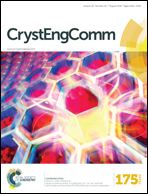In situ asymmetric island sidewall growth of high-quality semipolar (11![[2 with combining macron]](https://www.rsc.org/images/entities/char_0032_0304.gif) 2) GaN on m-plane sapphire
2) GaN on m-plane sapphire
Abstract
In situ asymmetric island sidewall growth (AISG) was developed to enhance Ga-face facet growth and improve the crystalline quality of (11![[2 with combining macron]](https://www.rsc.org/images/entities/char_0032_0304.gif) 2) GaN epilayers on m-plane sapphire substrates. In the early growth stage island shaping and sidewall faceting were distinct and controlled by growth design. Using in situ AISG, {0002} instead of {
2) GaN epilayers on m-plane sapphire substrates. In the early growth stage island shaping and sidewall faceting were distinct and controlled by growth design. Using in situ AISG, {0002} instead of {![[1 with combining macron]](https://www.rsc.org/images/entities/char_0031_0304.gif) 103} sidewall facets were formed on the Ga-rich island surface, which eliminated formation of a {
103} sidewall facets were formed on the Ga-rich island surface, which eliminated formation of a {![[1 with combining macron]](https://www.rsc.org/images/entities/char_0031_0304.gif) 103} phase during subsequent layer growth of semipolar GaN. Enhanced Ga-face sidewall facet growth led to +c regions overlapping −c regions, which reduced defect density. Pure semipolar (11
103} phase during subsequent layer growth of semipolar GaN. Enhanced Ga-face sidewall facet growth led to +c regions overlapping −c regions, which reduced defect density. Pure semipolar (11![[2 with combining macron]](https://www.rsc.org/images/entities/char_0032_0304.gif) 2) epilayers with a reduced surface striation density and a basal-plane stacking fault density of 8 × 103 cm−1 were obtained. The observation of a narrow EH2 peak and an intense E1(LO) peak in Raman spectra indicates that almost strain-free high-quality semipolar (11
2) epilayers with a reduced surface striation density and a basal-plane stacking fault density of 8 × 103 cm−1 were obtained. The observation of a narrow EH2 peak and an intense E1(LO) peak in Raman spectra indicates that almost strain-free high-quality semipolar (11![[2 with combining macron]](https://www.rsc.org/images/entities/char_0032_0304.gif) 2) GaN films were achieved. The photoluminescence emission intensity from the (11
2) GaN films were achieved. The photoluminescence emission intensity from the (11![[2 with combining macron]](https://www.rsc.org/images/entities/char_0032_0304.gif) 2) GaN film prepared by in situ AISG was dominated by band-edge emission and enhanced ∼4 times more than that from conventional (11
2) GaN film prepared by in situ AISG was dominated by band-edge emission and enhanced ∼4 times more than that from conventional (11![[2 with combining macron]](https://www.rsc.org/images/entities/char_0032_0304.gif) 2) GaN.
2) GaN.
![Graphical abstract: In situ asymmetric island sidewall growth of high-quality semipolar (11 [[2 with combining macron]] 2) GaN on m-plane sapphire](/en/Image/Get?imageInfo.ImageType=GA&imageInfo.ImageIdentifier.ManuscriptID=C6CE00878J&imageInfo.ImageIdentifier.Year=2016)

 Please wait while we load your content...
Please wait while we load your content...
![[2 with combining macron]](https://www.rsc.org/images/entities/h2_char_0032_0304.gif) 2) GaN on m-plane sapphire
2) GaN on m-plane sapphire